#The House of Grès
Explore tagged Tumblr posts
Text
24 novembre … ricordiamo …
24 novembre … ricordiamo … #semprevivineiricordi #nomidaricordare #personaggiimportanti #perfettamentechic
2023: Heidelinde Weis, attrice, regista e cantante austriaca. Dal 1959 ha recitato in numerose produzioni teatrali. Nel 1964 divenne nota come il personaggio del titolo in The Dead of Beverly Hills. Dal 1960 al 2015 è apparsa davanti alla telecamera in circa 115 produzioni cinematografiche e televisive. (n. 1940) 2023: Luca Sabatelli, costumista e scenografo italiano. Diplomato all’Accademia di…
#24 novembre#Alix#Alix Barton#Cabochard#Florence Agnes Henderson#Florence Henderson#Germaine Émilie Krebs#Grès#Harry Einstein#Harry Parke#Heidelinde Weis#Juliette Barton#La Maison Alix#Luca Sabatelli#Madame Grès#maestra dell&039;abito avvolto e drappeggiato#Morti 24 novembre#Nora Sampson#Noriyuki Morita#Parkyakarkus#Pat Morita#regina del drappeggio#Ruth Chatterton#Sfinge della moda#stile drappeggiato#Teddy Sampson#The House of Grès
0 notes
Text
Other Odysseys: 1954's Ulysses
When it comes to a cinematic adaptation of The Odyssey there is only one movie to know, THE movie, I am speaking of course about the 1954 Ulisse (or Ulysses in English).

In the middle of the 20th century, Italian cinema absolutely dominated the world when it came to peplums, adaptations of Roman history, or of Greek mythology. It is from this era that came so many famous, cult, classic or influential movie that later ended up creating this same craze in the USA (for example, the huge wave of Hercules movies that later led to the series of American Hercules movies - I made a post about it a loonngg time ago I never followed upon). And this specific movie still remains to this day a big name in the list of Odyssey adaptations.
Directed by Mario Camerini (with Mario Bava also being involved!), this movie had quite an international fame due to not being exclusively Italian. Most notably, it has quite an amount of Americans involved, Kirk Douglas even playing Ulysses! (or Odysseus if you prefer the Greek name) You also have Anthony Quinn as Antinous. France also had its share in the movie, with actors like Daniel Ivernel or Jacques Dumesnil playing men part of Ulysses's crew.

What to say that hasn't been said before? If you enjoy the Odyssey you must watch this movie. I prefer the French dub over the English one because it clarifies some details that are more vague and left to interpretation in the English dub, but that's just me. The costumes of the movie were designed by a French haute couture house: they were the works of Madame Grès. Some scenes were originally planned on Ithaca itself, but an earthquake prevented the shooting. And some of the weapons and armors were historical pieces, lended by museums from Greece and Italy.
If you are interested by how this movie handled the Odyssey, I'll let you discover this by youself (given it is a movie from the 50s it is easy accessible around, even on Youtube you've got several free versions in various languages), but I will tell you that the movie had to condense the Odyssey as much as it could, due to the limits of being a single movie AND a 50s production, while still producing a story that felt satisfactory and complete. I believe it did, though I might be biased because this was literaly the first time I saw the Odyssey on screen after reading about it, and it was one of my childhood movies.
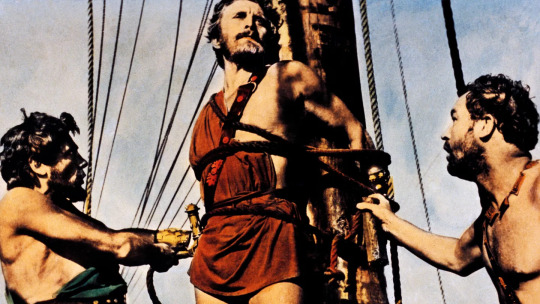
The most striking part of this piece being the synthesis of Ulysses' many trials into three specific steps, with the Nausicaa segment being the first third of the movie: it is a slow opening mimicking how the Odyssey itself begins, but with the additional detail that if Odysseus stays so long by Nausicaa's island, it is because he lost his memory. The sea adventures are actually Odysseus' narration as he finally starts to remember who he was - and this leads to the three iconic segments that marked the "Greek mythology cinema" of the time.
The Polyphemus segment, which was THE marking depiction of a cyclop on the silver screen ; the Siren segment, which explored this movie's tactic of purposefully not showing the most supernatural or gruesome elements of the tale, by the old theater trick (this movie has a strong theater vibe to it in terms or choices and staging) ; and finally the Circe segment. A segment where Circe is also Calypso and Charybdis all at once, and that chose to depict this mysterious enchantress as supernatural double of Penelope (both played by Silvana Mangano), forever clad in a green aura and acting in an eerily ambiguous and unnatural way which leaves you wondering if she is truly a divine witch loving in an unhealthy way Odysseus, or a malevolent agent of the god simply fooling him all along...
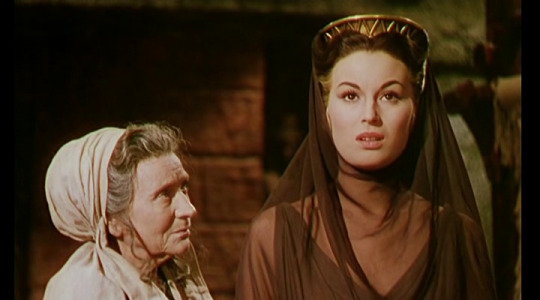
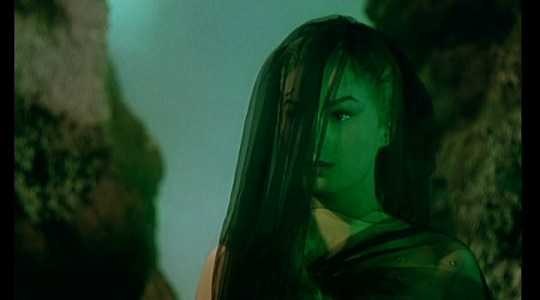
All in all, this is THE classic of the Odyssey adaptations that needs no introduction.
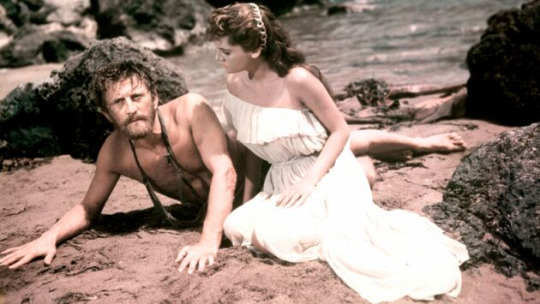
#odyssey#the odyssey#greek mythology media#other odysseys#odyssey adaptations#italian movies#greek mythology movies#ulysses#ulisse#1954 ulysses#circe#polyphemus#cyclop
16 notes
·
View notes
Text

US Vogue March 1, 1960
Grès Haute Couture Collection Spring/Summer 1960. White fleece (lamb) coat cut in the wide and wonderful way for which the Grès house is renowned. ; the deep yoke, front and back, is made from the reverse side of the fabric. White jersey dress; Green silk cummerbund.
Grès Collection Haute Couture Printemps/Été 1960. Manteau blanc de toison (agneau) coupé de la manière large et merveilleuse qui fait la renommée de la maison Grès. ; l'empiècement profond, devant et derrière, est réalisé à partir de l'envers du tissu. Robe en jersey blanc ; Ceinture de smoking en soie verte.
Model/Modèle : Anna Carin Bjorck Photo Jerry Schatzberg vogue archive
#haute couture#madame grès#grès#us vogue#march 1960#fashion 60s#spring/summer#printemps/été#anna carin bjorck#jerry schatzberg#vintage fashion
27 notes
·
View notes
Text
Dior, Alaïa, & Saint Laurent
I was fortunate enough to visit several haute couture house museums while in Paris! We explored La Galerie Dior on our second day in Paris along with the Fondation Azzedine Alaïa (which was also hosting an exhibit of Madam Grès' works) later that afternoon. Then, on the second to last day of our trip, we went on a guided tour of Fondation Pierre Bergé-Yves Saint Laurent.
Dior:
The first that we visited was the Dior Museum, which was dazzlingly maximalist. Definitely my style— I always prefer a more ornate, extravagant aesthetic as opposed to a minimalist one. Right from the get-go, the entry staircase was flanked by a massive glass wall displaying a rainbow of miniature Dior items. The museum was set up so that visitors would be taken through a chronological timeline of Christian Dior’s life and legacy. His designs transitioned from relatively classical and simple to over-the-top and lavish to somewhat of a combination in more recent times. The exhibits were divided into significantly different individual sections. The second section was especially maximalist, featuring some of Dior’s boldest works in front of artwork and underneath an abundance of hanging flowers. My photos don't quite capture it, but this part of the museum reminded me of the highly constructed, decorated, and dimly lit environments of aquariums— in a good way.
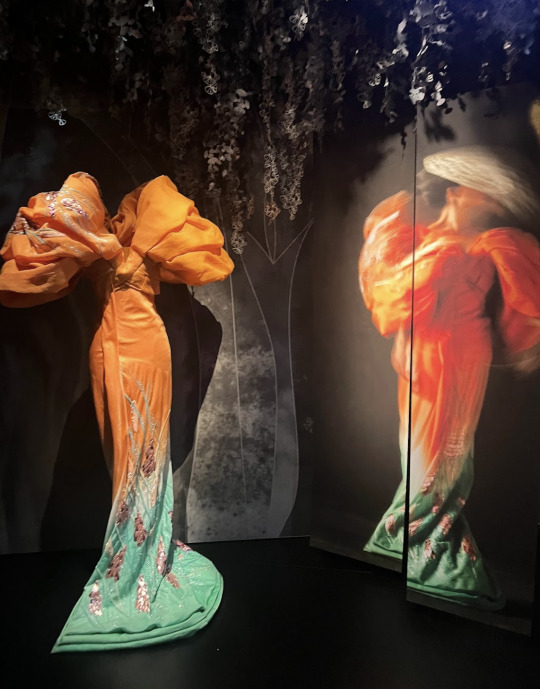



In high contrast, a following section of the museum was bright and featured white and red garments. This segment reminded me of a modern art museum or maybe even a laboratory, crisp and sterile.
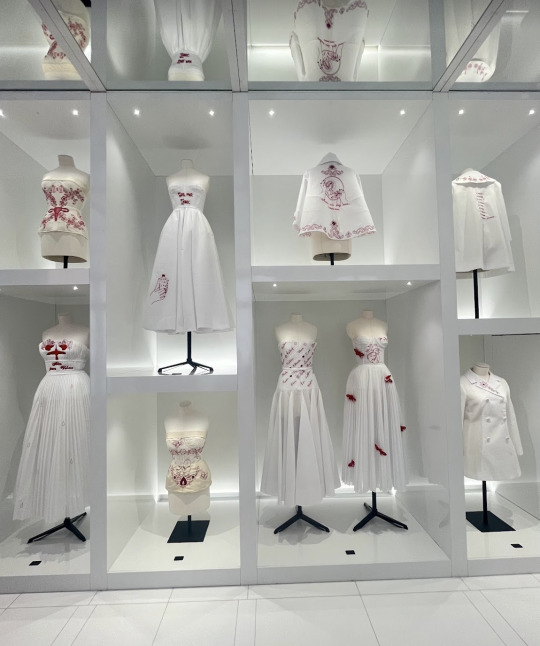
Dior's appreciation for historical period fashion was evident in many of his works. Here are a couple of my favorite designs of his inspired by the clothing of the past:
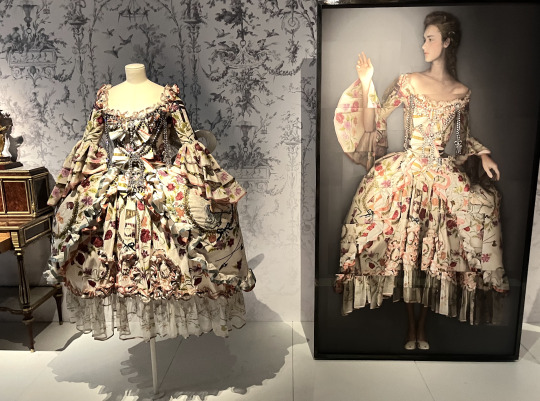
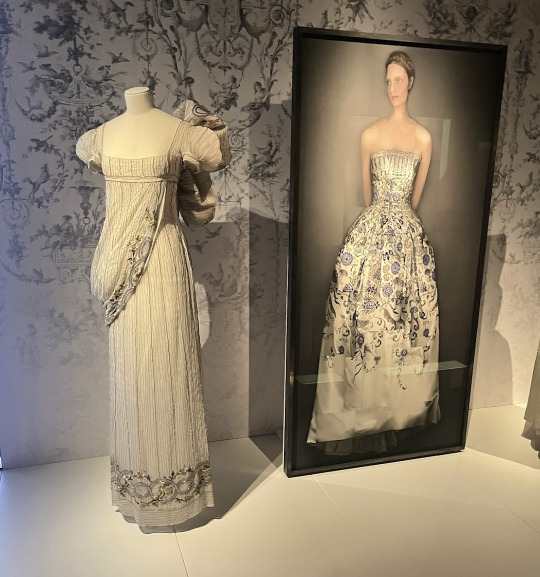
The language conveyed in Christian Dior's designs is definitely one of classic luxury. Dior’s fashion language prioritizes beauty over comfort and practicality. His work is ostentatious in a way that is commonly associated with old-world wealth— highly intricate and embellished, bold in colors, shapes, and/or texture, strictly feminine silhouettes— eye candy, basically, but often forgoing wearability and accessibility.
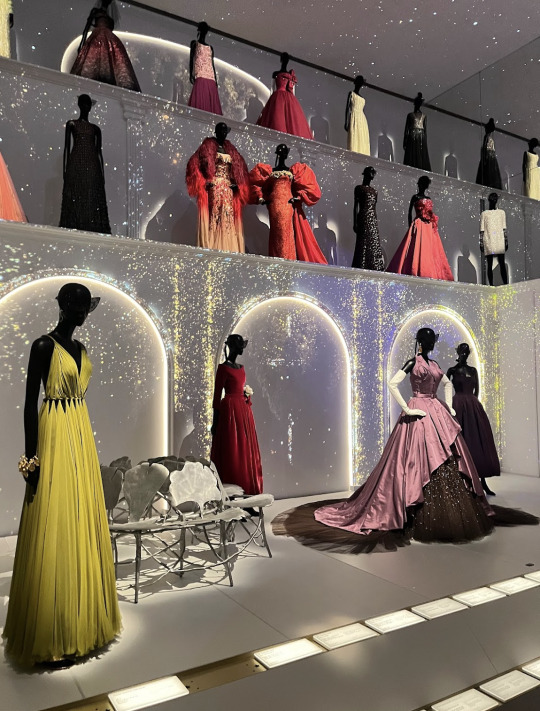
Alaïa:
After exploring the Dior Museum, we were taken on a guided tour of the Azzedine Alaïa Foundation. Unfortunately, I was too exhausted and sore to appreciate this exhibit as much as I would have liked to and because of that, I don't remember it as well as the Dior and Saint Laurent Museums. However, I do recall the stark difference between this museum and the Dior Museum. Alaïa's designs as well as the style of the exhibit itself were significantly more modern and minimalist. This is not my cup of tea, but I do think that they complemented each other well. My favorite part of this tour was examining the similarities and differences between Alaïa and Madame Grès' designs. The people who constructed the exhibit placed similar works from the two designers side-by-side so that they could be more easily compared and contrasted, which I appreciated. Alaïa and Grès had similar draping techniques and a shared love for monochromatic garments. Since there was no apparent experimentation or boldness with color, the designs instead were unique in their shapes and textures. Alaïa had an affinity for using sheer fabrics in his designs, whereas Grès was much more modest (as would be expected of that period).
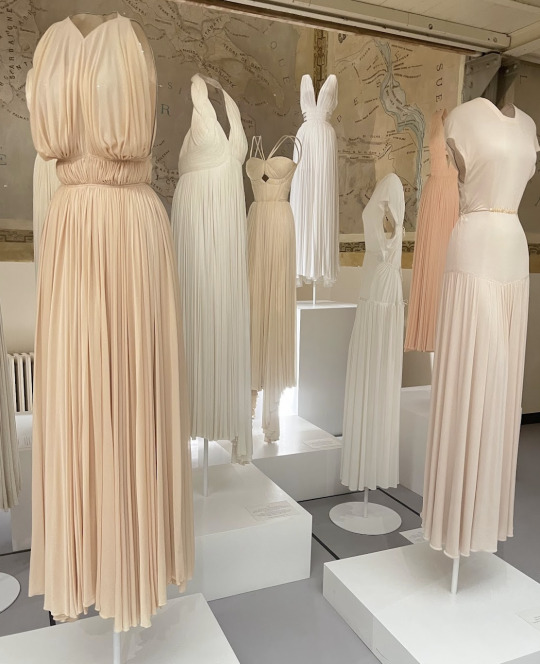
Alaïa’s designs imbue a language of modern elegance and liberation. His use of draping and sheer fabrics and general lack of intricate details draws the eye to the shapes and movement of his garments and, consequently, the people wearing them. Grès’ designs convey more classic elegance and simplicity while being somewhat more modest than Alaïa’s. Although I don’t typically have a preference for more modest clothing, I will say that while examining their works side by side, I gravitated towards Grès’ garments. It’s a bit difficult to explain, but they looked like they were designed by a woman. They were constructed in a way that seemed especially considerate and knowledgeable about women’s bodies. I could picture myself in her dresses, but I couldn’t see myself wearing almost any of Alaïa’s designs. They looked uncomfortable in a way that’s tough to convey. It wasn’t necessarily the fabric or the shapes, I think that, at least partly, it was the cuts and sheer fabric placed in inconveniently revealing areas. Many of his dresses looked like the type that I would be fiddling with and checking on constantly if I were wearing them, always anticipating a wardrobe malfunction. Based on what I’ve learned about him, I do think that the intended fashion language in his designs was to be liberating for women, but it just didn’t quite resonate with me.
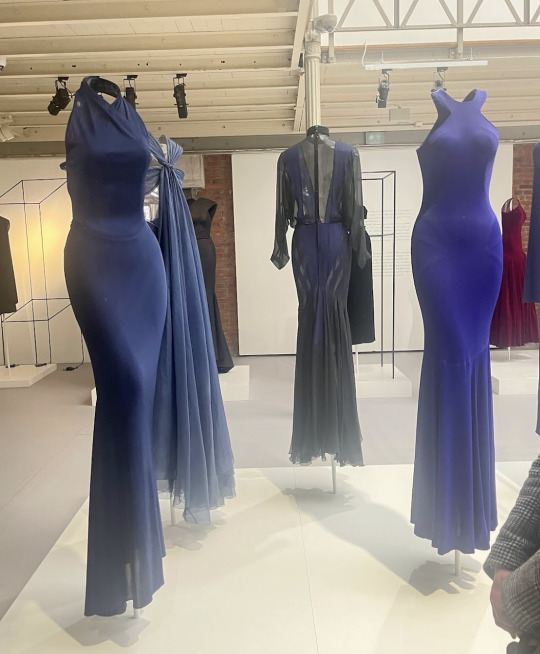
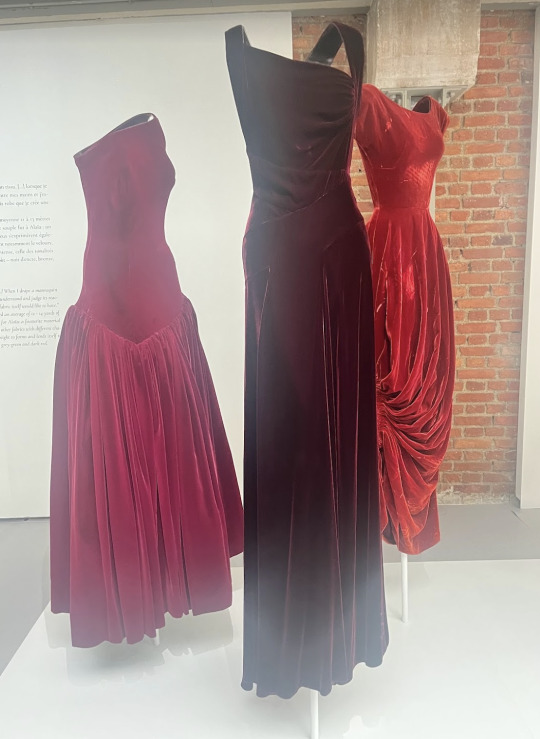
Saint Laurent:
For a multitude of reasons, the Yves Saint Laurent Museum was my favorite out of the three! Yves Saint Laurent revolutionized women’s fashion. He invented the women’s smoking tuxedo, popularized ready-to-wear collections, merged artwork and fashion, championed racial diversity in the modeling world, and so much more. Watching the YSL movie in class on top of the familiarity I already had with the designer and the brand made me all the more excited to see this museum! Part of this exhibit highlighted Saint Laurent’s use of sheer fabrics in his work such as chiffon, lace, and tulle with the intent of liberating women’s bodies. In contrast to some of Alaïa's pieces with smaller sections of sheer fabric, Saint Laurent's pieces were often entirely sheer or with large cutouts. This distinction made Saint Laurent's use of transparent fabric feel more assertive than Alaïa's.

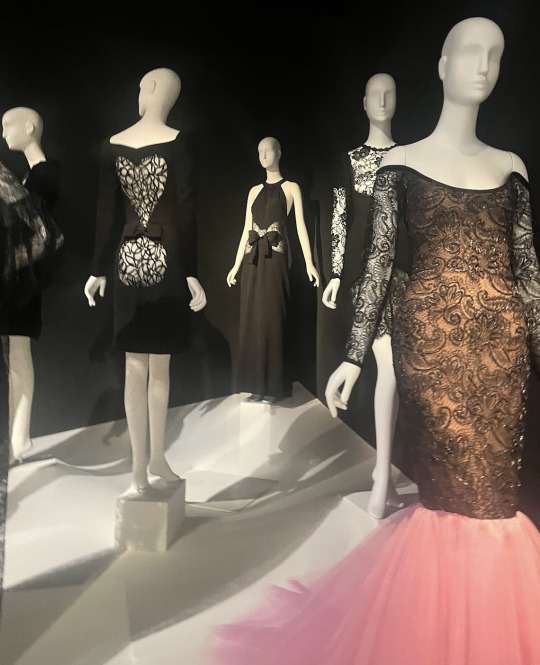
Saint Laurent also layered sheer fabrics to create an illusory appearance to his designs, giving them a depth and softness that I really admired.

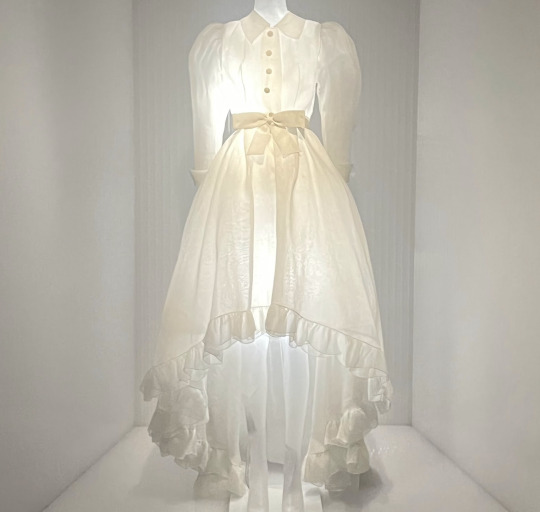
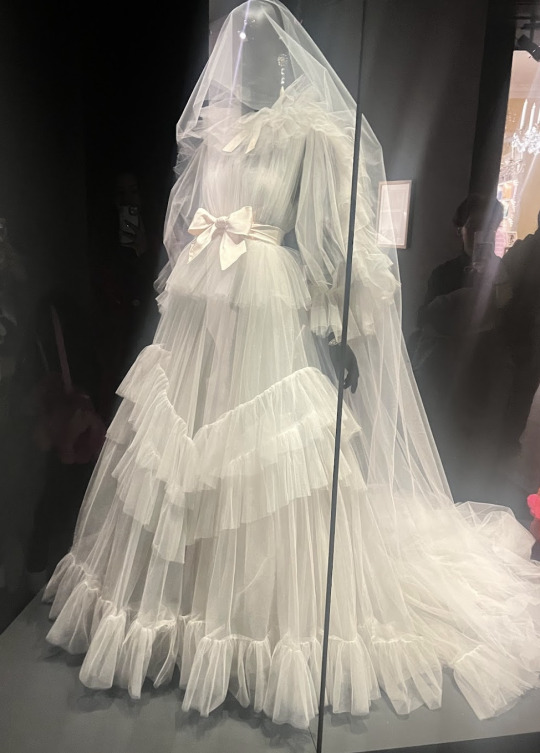
Much of his work also had a looseness to it, present in many of the photos above, that contributed to the language of liberation Saint Laurent conveyed through his clothing designs. They look comfortable and freeing, like the woman is wearing the clothes, not the clothes wearing the woman.


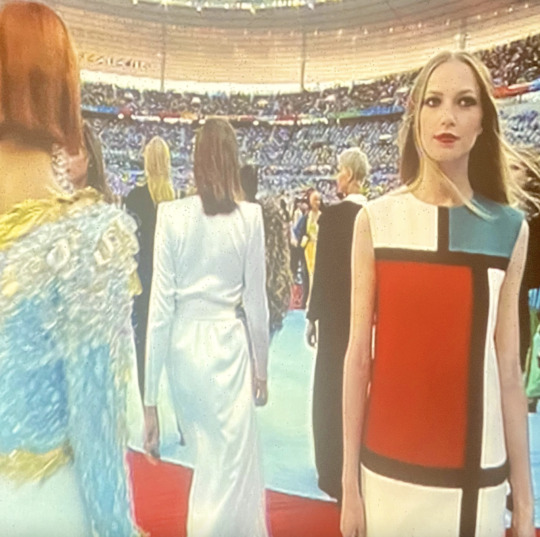
The comfort and freedom that Saint Laurent exudes through his designs is something I didn't find particularly present in either Dior's or Alaïa's work. Their clothes may be for women, but Saint Laurent's work is truly for women.
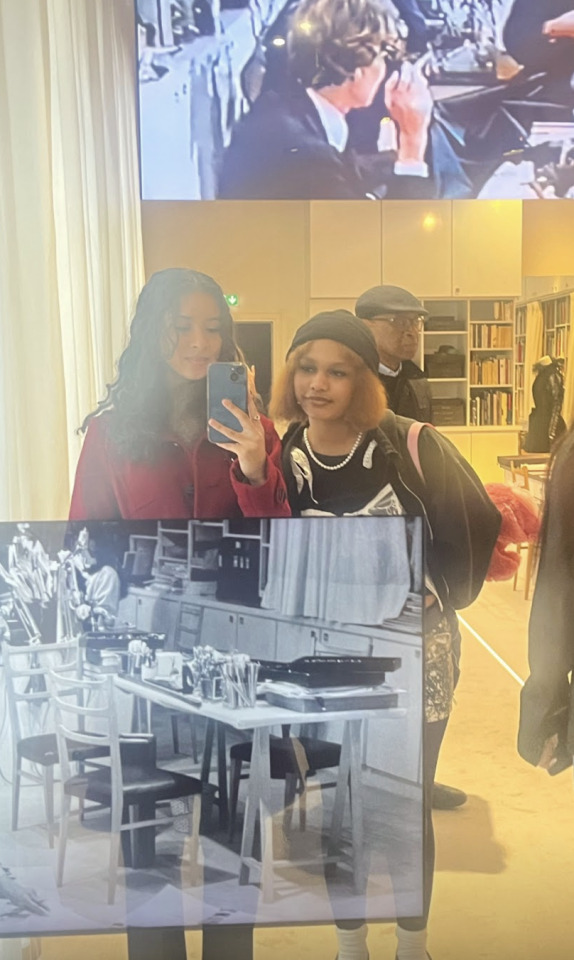
Sources: My own memory, my own photos.
2 notes
·
View notes
Text
What Will Be Vintage of Tomorrow?
1. What Defines a Future Vintage Piece?
Timely and Timeless:
Future vintage pieces must resonate with their era while remaining relevant across decades.
Harold Koda, curator at the Metropolitan Museum of Art, describes collectible designs as having:
Wide influence.
Representation of their time.
Unique individuality.
Cultural Significance:
Iconic moments in fashion, like Angelina Jolie’s Golden Globes gown or signature designs from leading fashion houses (e.g., Versace and Madame Grès), establish a historical and cultural connection, increasing their future desirability.
2. Characteristics of Future Vintage
Limited Availability:
Exclusivity is a key driver; pieces with limited production runs or unique designs are more likely to become collector's items.
Examples include Tiffany & Co.’s limited-edition jewelry by Frank Gehry or collections from Viktor & Rolf for H&M.
Signature Designs:
Designs that define a brand or designer’s legacy are prime candidates for future vintage.
Examples:
Prada’s ombré prints (Spring 2004).
Chloé’s black-trimmed A-line dresses (Spring 2005).
Craftsmanship and Quality:
Superior craftsmanship ensures durability, making items suitable for preservation and reappreciation.
3. Trends and Recommendations
Collectible Designers and Pieces:
Rachel Zoe highlights timeless collections like vintage Pucci and Missoni as examples of enduring appeal.
Luxury-retail expert Robert Burke predicts current pieces that may gain vintage status, such as Oscar de la Renta's evening dresses.
Balancing Fashion and Functionality:
Collectors are advised to select items that maintain relevance across life stages, avoiding overly trendy or one-season items.
Emerging Designers:
Supporting up-and-coming talents like Rodarte and Phillip Lim offers the potential to own future vintage items with unique qualities.
4. The Collector’s Perspective
Emotional Connection:
Collectors value items that evoke personal meaning or reflect iconic cultural moments.
Liz Goldwyn, a vintage aficionado, views collecting as an obsessive pursuit tied to storytelling and historical preservation.
Investment in Accessories:
Accessories like Balenciaga’s motorcycle bags or Chanel’s tweed trenches are highlighted as high-impact, collectible items.
Competitiveness and Secrecy:
Savvy collectors often keep their discoveries secret to maintain exclusivity and competitive advantage.
5. Implications for Fashion Brands and Consumers
For Designers:
Brands should create designs with long-term appeal, focusing on quality, timelessness, and cultural resonance.
For Consumers:
Buyers are encouraged to choose pieces that align with their personal style and have lasting significance rather than chasing fleeting trends.
Conclusion
The article underscores the importance of exclusivity, craftsmanship, and cultural relevance in determining the vintage potential of today’s fashion. It advises collectors and brands to focus on timeless qualities and emotional connections, ensuring pieces remain relevant and valuable in the decades to come.
0 notes
Text




















This is day 2!!!! For my first full day in Paris I woke up very tired due to jet lag, and hearing my roommates coming back late from exploring the different nightlife areas in Paris. On the second day I was able to go and see the Dior Galleria, and was in absolute love! I got to see many of the pieces that I idolized. I wish I could've tried on the dresses for display, but unfortunately the pieces are too delicate to wear. Luckily I was able to create an appointment way in advance to be able to buy my first piece of Dior clothing, and it made me cry because I dreamt of this moment my whole life and was able to also try on some of the dresses from the latest line at the time.
After going to the Dior Galleria I was also given the chance to explore the different fashion houses that were on the most famous street! It was truly an experience to be able to shop, try on clothing, and live a moment in the lifestyle that I truly want. After the exploration of the most famous fashion houses I was then ushered to the Azzedine Alaïa foundation and got to see how him and Madama Grès' dresses were so similar yet so different. Along with being able to see the studio of Alaïa before he died and how it still looks the same even after his death.
Finally as we were able to depart to see Paris by ourselves my small group went out to go thrifting and then decided to explore, but I was left behind and decided to meet my group up at a local fabric store. I didn't see anybody, so I decided to tackle the metro by myself. It was very easy, and the best part about it I got to try Starbucks in another country, and was able to brag about it to my mom who has always wanted to try Starbucks in the EU. While on the metro I was looking at the time and saw that I had to head to the dinner appointment at Chez Edward. When leaving the metro I saw so many designer boards and it was awesome. As I walked to the restaurant I got to see home furnishing places and wanted to buy things from there for my aunt, and decided not to. Food was good as usual, and while everyone went to the Eiffel Tower to take photos I went to bed to wake up energized while everyone woke up groggy again for the second time.
0 notes
Photo

Nina Ricci (birth name Maria Adélaide Nielli) was born on January 14,1883 in Turin, Italy. She was an Italian-born French fashion designer.
Nina Ricci moved with her family to France in 1895 aged 12. When Ricci was 13 she began an apprenticeship with a dressmaker.
Throughout her teenage years, Nina continued to chase her love for the fashion world. Along the way, she married Luigi Ricci, a composer and jewelry designer in 1904. The couple had a son named Robert. Four years after her marriage, in 1908 she joined Raffin, a fashion house, as a designer and worked there for next two decades. Soon she became a partner of Raffin and in 1932 became capable of establishing her own design company. At the time, Nina was forty-nine years old and was curious to create designs herself under her name. She designed the dresses while her son managed the finances and business on the whole. In order to make sure that the fabrics fitted together in the right way, she worked on the mannequin directly. Shortly, all her design collections became popular for their feminine, romantic and refined feel.
All through the thirties, the Nina Ricci House expanded rapidly and the one room place became three buildings with eleven floors each. The business operations, by the second world war, developed and included trendy accessories and leather commodities.
After the war, in 1945, designers tried to revive women’s infatuation with haute couture like before and at the same time attempted to raise money for relief funds. With the help of Lucien Lelong, Chambre de Commerce, Robert Ricci put his idea into action. An exhibition was held at Louvre, where more than 145 mannequins from 40 fashion designers in Paris, including Grès and Balenciaga were dressed in the best designs by the labels. After succeeding with this plan in one city, the exhibit toured most parts of Europe and then USA.
In 1935, Nina described the way she desired to design dresses: they should be light weighted, flowy and perfect for dancing; elegance and detail of the dress should attract clients and become their favorite; and lastly they need to be sober and appealing to young fashion minds.
Nina Ricci sketched out her ideas on paper, with colors and placing the model in a setting. She was highly proficient in using fabrics and other materials. Whenever she found a fabric she liked, it was used in the most effective manner. For example, once she saw black floral bordered silk and she cut a dress pattern that fitted flowers on the bust and the rest of the gown was plain black.
She dedicated most of her life to this field and loved dressing women. The geographical locations of her birth and youthful years, Italy and France, helped Nina to develop a strong aesthetic sense for quixotic, luxurious and distinguished clothing. Nina herself wore exclusive clothes and jewelry, designed by her husband, to parties.
In 1948, Nina’s label introduced L’Air du Temps, which was co-designed by her son and Marc Lalique. In the 1950s, when Nina was almost seventy years old, she gradually departed from design and chose to only direct the house. In 1954, Jules Francois Crahay became the head designer of the brand.
Nina Ricci died in 1970 at the age of 87 and eighteen years later her son died too. The company they found is now being run by Robert’s son-in-law, Gilles Fuchs.
Daily inspiration. Discover more photos at http://justforbooks.tumblr.com
17 notes
·
View notes
Photo

Majed Zalila | Instagram | Pinterest | Art Club House
Title : Au grès du vent
Year : 2019
Size : 23,6 x 16,5 in. (60 x 42 cm)
Techniques : Drawing on Paper
Artist : Majed Zalila
10 notes
·
View notes
Photo










Madame Grès Sculptural Fashion
Olivier Saillard
Hannibal Publishing, Veurne 2012, 216 pages, ISBN 978-9491376276
euro 180,00* sold out at the publisher
email if you want to buy :[email protected]
The first complete monograph on the work and life of Madame Grès, icon of the Paris Haute Couture.
This monograph is the only book on Gres in print in English and the largest yet published on her life and work. . .Design drawings, period photographs, and new photographs of the garments on mannequins attest to the astonishing timelessness of Gres’s vision. . .plentiful photographs documenting the oeuvre of a major couturiere make this catalog a welcome addition to the literature of fashion.
Madame Grès launched her design house under the name Grès in Paris in 1942. Formally trained as a sculptress, she produced haute couture designs for an array of fashionable women, including the Duchess of Windsor, Marlene Dietrich, Greta Garbo, Jacqueline Kennedy and Dolores del Rio. Her signature was cut-outs on gowns that made exposed skin part of the design, yet still had a classical, sophisticated feel. She was renowned for being the last of the haute couture houses to establish a ready-to-wear line
Exhibition at the MoMu Fashion Museum, Antwerp from September 2012 - February 2013
Olivier Saillard is currently director of Galliera, the Paris Museum of Fashion. A renowned fashion historian, he has been the curator of many successful exhibitions such as the one dedicated to Madame Grès
orders to: [email protected]
twitter: @fashionbooksmi
flickr: fashionbooksmilano
instagram: fashionbooksmilano
tumblr: fashionbooksmilano
#Madame Grès#sculptural fashion#Paris Haute Couture#rare books#out of print books#MoMu Antwerp#fashion exhibition#fashion inspiration#Grecian style sculpture#fashion books#fashionbooksmilano
37 notes
·
View notes
Photo

Velvet jacket
by Madame Grès
1939
Madame Grès (1903–1993) born Germaine Émilie Krebs, also known as Alix Barton and Alix, was a leading French couturier of her generation and costume designer. She founded the former haute couture fashion house "Grès" as well as the associated perfume house "Parfums Grès" which still exists today in Switzerland. Remembered as the "Sphinx of Fashion", Grès was notoriously secretive about her personal life and was seen as a workaholic with a furious attention to detail, therefore she preferred to let her work do the talking. Called the "master of the wrapped and draped dress" and "queen of drapery”, Grès is best known for her floor-length draped Grecian goddess gowns. Grès's minimalistic draping techniques and her attention and respect for the female body have had a lasting effect on the haute couture and fashion industry and she is credited for inspiring a number of recent designers.
In 1932, Grès opened her first couture fashion house, La Maison Alix. In 1933, Grès and her coworker, Juliette Barton, combined their names to create Alix Barton, which she designed under for a short amount of time. Grès dropped the "Barton" in 1934 and designed under her own name, "Alix", for the remainder of the 1930s and up until 1942. During this time, Grès's signature style of classical drapery and elegant gowns became the signature of the couture fashion house. At this time she became known for her technique of using live mannequins, designing and creating garments directly on the models. Her early work shows Greco-Roman sculpture influences as well as simple lines and attention to the female body.
In 1942, after marrying Russian painter, Serge Czerefkov, Grès began designing under the name "Madame Grès", a partial anagram of her husband's first name During World War II, after creation of the Madame Grès label, German troops invaded Paris and soon occupied it. During the war, German forces demanded that Madame Grès design bleak and utilitarian clothing which was in complete contrast to her entire collection. Grès defied their orders and continued to design garments that mirrored the colors of the French flag. Consequentially, after defying German's orders, German forces ordered Grès's haute couture fashion house to be closed claiming her generous use of fabric during wartime as their reasoning. After the closing of her first couture house, Grès fled to the Pyrenees and stayed there until Paris was liberated. In 1944, with the closing of her first couture house, Grès began designing again and opened her second house returning to her now signature name, Madame Grès. Throughout the 1940s, Madame Grès began constructing and perfecting her most notable garment, the elegantly draped Grecian goddess gowns. These dresses could take anywhere up to three hundred hours to complete with each pleat being done by hand draping the cloth so the body shaped the dress. Grès's signature dress perfectly captures who Grès was as a fashion designer. Her painstaking attention to detail, regard for the human body, and simplistic effects can be seen in each of her gowns. In the 1950s, Grès experimented with simpler cuts and purer lines using ethnic traditions such as saris, kimonos and serapes as her inspiration. In addition, Grès tried her hands as tailoring women's suits over the course of the 1950s. Grès's design focus remained mostly on her couture gowns throughout the rest of her career. Grès debuted her bestselling fragrance, Cabochard, in 1959 which translates to "stubborn". In 1970, Grès strayed away from her signature draping style and highlighted naked flesh. She highlighted the flesh by constructing vertical peek-a-boo openings in the bodice. Grès continued to design at her fashion house up until her 80's when she retired from the Grès fashion house in the late 1980s. The final garment designed by Madame Grès was a swelling bodice dress ordered by Hubert de Givenchy in 1989.
38 notes
·
View notes
Text
24 novembre … ricordiamo …
24 novembre … ricordiamo … #azzaro #semprevivineiricordi #nomidaricordare #personaggiimportanti #perfettamentechic #felicementechic #lynda
2005: Pat Morita, Noriyuki Morita, attore e doppiatore statunitense. è stato un attore e doppiatore statunitense di origine giapponese. È noto per l’interpretazione del maestro Kesuke Miyagi nella tetralogia Karate Kid e per il ruolo di Matsuo “Arnold” Takahashi nella serie televisiva Happy Days. Si è sposato tre volte: prima dal 1953 al 1967 con Kathleen Yamachi da cui ha avuto un figlio; poi…
View On WordPress
#24 novembre#Alix#Alix Barton#Cabochard#Germaine Émilie Krebs#Grès#Juliette Barton#La Maison Alix#Madame Grès#maestra dell&039;abito avvolto e drappeggiato#Morti 24 novembre#Noriyuki Morita#Pat Morita#regina del drappeggio#Sfinge della moda#stile drappeggiato#The House of Grès
0 notes
Text
GALILEO house is a project designed by CMQ architettura. The project is set in a small 75sqm apartment located in one of these buildings. The interior layout of the apartment has remained unchanged since its construction, with a blind corridor that served as the entrance and gave access to the various spaces of the house.
#gallery-0-6 { margin: auto; } #gallery-0-6 .gallery-item { float: left; margin-top: 10px; text-align: center; width: 25%; } #gallery-0-6 img { border: 2px solid #cfcfcf; } #gallery-0-6 .gallery-caption { margin-left: 0; } /* see gallery_shortcode() in wp-includes/media.php */
The freedom of the program has allowed us to investigate the value of an apartment that had no specific architectural quality. We realized that the conformation of the building lets the apartment to gather direct natural light all day long through three different views facing East, South and West. This characteristic has led to the realization of a unique space that could restore a relationship with the light in every point of the house, making the Earth revolution to be perceived within a small domestic space.
By denying any division, the entrance, the living room, the kitchen and the bedroom are placed in a single space that extends from one side to the other, allowing the external element of light to cyclically change the perception of the house in every point of the apartment. The service areas of the cloakroom, the bathroom and laundry have been designed by subtraction and have been treated through pure walls, which soften their presence.
The different materials tension the image of a unique space to allow different degrees of intimacy within the house. The entrance, the living room and the kitchen are made of typical Milanese stone, “Ceppo di Grè”, while the room and its connection with the rest of the house are made of in wood. Placing these materials on the walls made it possible to generate a domestic atmosphere, which, in one case is translated into the background of the memories of the owner, while in the other wraps up a small reading space. the blue painting, from simple decoration, becomes the linking element of all the environments.
GALILEO house by CMQ architettura GALILEO house is a project designed by CMQ architettura. The project is set in a small 75sqm apartment located in one of these buildings.
2 notes
·
View notes
Video
youtube
MESA TOP LOOP - MESA VERDE NATIONAL PARK - COLORADO
** Navajo Canyon Overlook
Coordonnées GPS: 37.16688, -108.49288 Arrêt photo
Ce belvédère, situé à une altitude de 2130 mètres, offre une toile de fond spectaculaire sur le Navajo Canyon.
La mesa abrite plus de 1 000 espèces de plantes et d'animaux. Ces espèces fournissaient jadis de la nourriture, des outils, des vêtements et des médicaments au peuple ancestral Pueblo.
** Square Tower House Overlook
Coordonnées GPS: 37.16668, -108.49135 Stationnement et début du sentier Coordonnées GPS: 37.16572, -108.49159 Belvédère Coordonnées GPS: 37.16594, -108.49134 Square Tower House
Un petit sentier mène à un point de vue de cette habitation située dans la falaise. Square Tower House a été habitée entre 1200 et 1300 après Jésus-Christ.
Elle tire son nom de la tour inhabituelle de quatre étages qui se dresse contre le mur arrière incurvé de l'alcôve. Certains murs intérieurs de la tour ont été plâtrés. Une source sous l'alcôve fournissait de l'eau aux habitants.
** Sun Point View
Coordonnées GPS: 37.16184, -108.47495
Ce belvédère offre une vue panoramique sur Fewkes et Cliff Canyons où ont été érigées les habitations suivantes: Sun Temple, Mummy House, Oak Tree House, Fire Temple et Cliff Palace.
** Oak Tree House Overlook
Coordonnées GPS: 37.16330, -108.47690 Belvédère Coordonnées GPS: 37.16463, -108.47736 Oak Tree House
Ce site de 60 pièces construit sur deux corniches est l'une des plus grandes habitations rupestres de ce parc. C'est un site bien conservé mais fragile. Il présente des murs en plâtre et des styles architecturaux variés.
** Fire Temple Overlook
Coordonnées GPS: 37.16469, -108.47923 Belvédère Coordonnées GPS: 37.16543, -108.47926 Fire Temple
Ce belvédère montre comment les constructeurs ont utilisé des couches naturelles dans le grès pour construire cette habitation à deux niveaux et le centre cérémoniel.
Les trous que l'on aperçoit sur le rebord de la falaise entre les deux ruines indiquent qu'une échelle reliait les deux niveaux.
** Sun Temple
Coordonnées GPS: 37.16510, -108.47576 Début du sentier Coordonnées GPS: 37.16472, -108.47556 Sun Temple Coordonnées GPS: 37.16522, -108.47551 Cliff Palace Overlook
Sun Temple est le dernier arrêt sur Mesa Top Loop Road. Un sentier en boucle de 200 mètres mène à Sun Temple, une structure cérémonielle, ainsi qu'à un belvédère qui offre une superbe vue sur Cliff Palace.
Des études récentes révèlent que Cliff Palace contenait 150 chambres et 21 kivas et avait une population d'environ 100 personnes.
Si vous désirez obtenir plus d'informations à propos de ce parc, je vous invite à visiter ce site web: https://www.nps.gov/meve/index.htm
***************
AUTRES VIDÉOS DE CE ROAD TRIP:
https://www.youtube.com/playlist?list=PLlRroQCNvchsdvRQOTUATm7OU6BabhYIF
ABONNEZ-VOUS ► https://www.youtube.com/c/SouthAngelVideo?sub_confirmation=1
SUIVEZ NOUS :
• BLOGGER ► http://southangelvideo.blogspot.ca/ • INSTAGRAM ► https://www.instagram.com/annestrasbourg/ • FLICKR ► http://www.flickr.com/photos/anne_strasbourg/collections/ • TWITTER ► https://twitter.com/AnneStrasbourg
0 notes
Photo
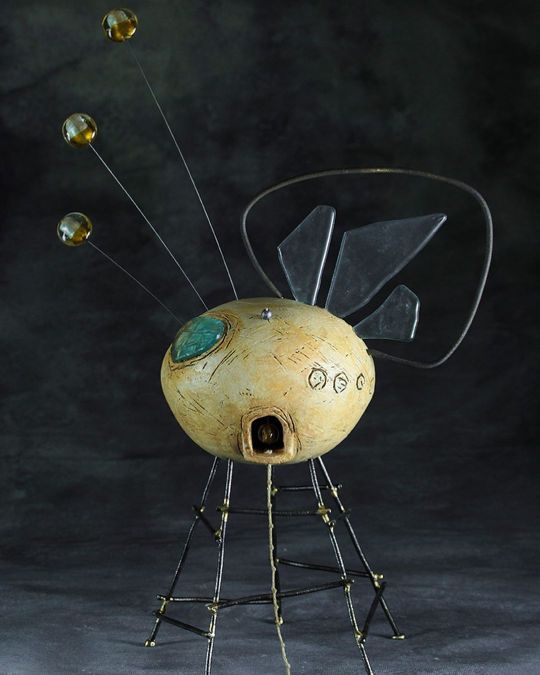
“Pilori, pilota, . . . “Poule House” et puis s’en va. Grande maison passive. Chauffe en captant et en combinant les neutrinos de l’espace et les photons du soleil. Grès, acier brasé, verre moulé, perles de verre et pincée d’utopie joyeuse. . . . #gres #ceramiqueetverre #ceramiqueetmetal #sculptureceramique #sculpture #ceramic #ceramique #contemporaryceramic #céramiquecontemporaine #formationprofessionnelle #artceramique #ceramiquesculpture #artisanat #pottery #poterie #lagedefaire #stagedepoterie #workshop #artisan #keramik #craft #ceramicart #clayart #stagepro #rakupottery #clay #potteryworkshop #capitale_ceramique @saintquentinlapoterie #gard #france (à Saint-Quentin-la-Poterie) https://www.instagram.com/p/Co-WG_UDU9w/?igshid=NGJjMDIxMWI=
#gres#ceramiqueetverre#ceramiqueetmetal#sculptureceramique#sculpture#ceramic#ceramique#contemporaryceramic#céramiquecontemporaine#formationprofessionnelle#artceramique#ceramiquesculpture#artisanat#pottery#poterie#lagedefaire#stagedepoterie#workshop#artisan#keramik#craft#ceramicart#clayart#stagepro#rakupottery#clay#potteryworkshop#capitale_ceramique#gard#france
0 notes
Text
C'était autrefois un terrain de golf immaculé où des footballeurs tels que Michael Owen et Dietmar Hamann jouaient.De nos jours, les seuls trous sont ceux faits par les blaireaux et les pics. Au lieu de golfeurs, des jeunes arbres de bouleau verruqueux défilent sur les verts.Au cours des deux années qui ont suivi sa fermeture, le parcours de golf de Frodsham dans le Cheshire s'est régénéré. Aujourd'hui, il est en train d'être transformé en bois public après avoir été acquis par le Fiducie des bois.Le parcours de 18 trous fait partie d'un nombre croissant d'étendues de terrain autrefois exclusives consacrées au golf qui sont mises à une nouvelle utilisation plus conviviale pour la communauté alors que les militants attirent l'attention sur la valeur des espaces verts à proximité des zones urbaines."Nous sommes vraiment enthousiasmés par cet endroit", a déclaré Simon Mangeean du Woodland Trust, donnant au Guardian une visite exclusive des fairways désormais appréciés par les joggeurs et les promeneurs de chiens locaux. «Pendant le verrouillage, les gens sont sortis et ont pratiquement réquisitionné l'espace. Une fois que l'opportunité est là, cela devient presque comme une terre commune.Le parcours de golf de Frodsham a fermé pendant la pandémie. Lorsqu'il a été mis en vente, les résidents locaux craignaient que le site pittoresque de 94 acres (38 hectares) ne devienne un lotissement. Au lieu de cela, il a été acheté par une fiducie caritative et loué au Woodland Trust, qui doit permettre la régénération naturelle parallèlement à la plantation d'arbres et à la création de clairières riches en fleurs sauvages.À Brighton, le terrain de golf Waterhall, propriété du conseil, est en train d'être réensemencé, tandis que l'ancien parc 18 trous de Beckenham Place a été transformé en le plus grand parc du sud-est de Londres. D'autres cours appartenant au conseil en Exeter et Sunderland sont également transformés en espaces verts sauvages pour l'homme et la nature.À l'extrémité nord d'une crête de grès qui traverse le Cheshire, l'ancien parcours de Frodsham offre des vues spectaculaires sur Frodsham Marsh, une zone humide protégée au niveau international, et à travers la Mersey jusqu'à la cathédrale anglicane de Liverpool à l'horizon lointain.Le site devient le dernier ajout à la Forêt du Nordun effort pour ajouter 50 m d'arbres à 10 000 miles carrés du nord de l'Angleterre, principalement sans arbres, de Liverpool à Hull.Transformer le parcours en bois reconnectera les anciens bois de Frodsham Hill Woods, Snidley Moor et Woodhouse Hill. "C'était une opportunité hautement stratégique car elle se heurtait à une forêt ancienne", a déclaré Mangeean. "Avec cette terre, nous pouvons protéger notre forêt ancienne, en particulier de la dérive de pulvérisation de pesticides et d'herbicides des terres agricoles, et rendre cet habitat plus grand, meilleur et plus uni."Les arbres plus anciens, y compris certains frênes vénérables et d'autres espèces indigènes plantées par le terrain de golf, seront conservés, les geais et les écureuils aidant à planter les glands des vieux chênes bordant le site. Des volontaires de la communauté locale planteront également des arbres à partir de semences locales.Un tiers du parcours restera un espace ouvert tel que des clairières semées de fleurs sauvages, conservant ainsi les vues spectaculaires sur la Mersey ainsi que les espèces de prairie biodiversifiées. "Ce ne sera pas du tout des arbres mur à mur", a déclaré Mangeean. Pendant ce temps, le club-house a été transformé en crèche pour enfants Ashton House et le Woodland Trust espère que la nouvelle forêt offrira des opportunités forestières aux enfants d'âge préscolaire ainsi qu'aux écoles primaires et secondaires locales.Le plan a été bien accueilli par les marcheurs locaux. "Je suis content", a déclaré Cliff Seeger. « J'ai entendu dire qu'ils allaient y planter des milliers d'arbres supplémentaires. Il y a de la place pour beaucoup plus d'arbres et l'environnement a besoin de plus d'espaces verts.
"C'est comme si un parc de campagne s'était ouvert", a déclaré Sophie Gibson. “Je pense que certains golfeurs ne sont pas aussi heureux, mais c'est un endroit charmant avec de superbes vues.”Mais dans le bourg voisin de Frodsham, il est difficile de trouver des dissidents, même parmi les golfeurs. Un golfeur local a déclaré : « C'est une bonne nouvelle, c'est bien mieux que de construire des logements dessus."Nous sommes tous ravis", a déclaré Jayne Davies, propriétaire de l'animalerie Tail Mates et du café acceptant les chiens. « C'était un très beau terrain de golf, mais c'est bien d'avoir quelque chose pour tout le monde. Tout le monde ne joue pas au golf – une forêt est plus universelle."C'est une bonne chose de voir des gens utiliser cet endroit, sortir pour faire de l'exercice ou se nourrir spirituellement", a déclaré Mageean. Le Woodland Trust n'est pas contre les terrains de golf, mais souhaiterait davantage de liens respectueux de la faune. « La valeur de la biodiversité des terrains de golf pourrait être massivement augmentée s'ils changeaient leurs pratiques de gestion conventionnelles. Si j'étais golfeur, j'aimerais voir plus de fleurs sauvages à l'état brut par exemple.Le militant et écrivain Guy Shrubsole, qui a lancé une pétition pour ouvrir les terrains de golf urbains au public pendant la pandémie, a déclaré que la conversion de Frodsham en bois était un bon signe. « Les terrains de golf occupent une part disproportionnée de notre ceinture verte et des espaces verts des villes. Dans les zones urbaines, beaucoup plus d'entre eux doivent être réaménagés en parcs publics remplis d'animaux sauvages plutôt qu'en verts entretenus.La crête de grès de Frodsham est riche en archéologie, des forts de colline de l'âge du fer aux tertres de l'âge de pierre. Mangeean a ajouté : "Je me demande ce que les archéologues du futur penseront des bunkers sablonneux au milieu d'une forêt ?"
0 notes
Photo

🌆 Cathédrales de Bambous 🎋 Rendez-vous sur SoundCloud 🎧 pour prêter l’oreille les amis! Les mots du portfolio y sont susurrés! 🙌 Expo 📸 photos @cyrillebellier / @afhongkong / @frenchmayartsfest « Sièges cathedra - 260 direct - nous voilà enveloppés de nos épiscopales Lianes; vrillons à la va-vite, au travers des cataractes étales de vermeil et de grès Dans nos douces langages, dérobées, le vent gifle joues nues car le vent veut jouer Et passe Tai-Tam le Pont, la Muraille belle passerelle qui mène aux libertés. Ce pont de nos bras trace la violente espérance de parvenir au but qui n’est que le début, Fileur éternel des immobilités bleues, au loin tu devines Murray House Le monde est beau dit-on et en dehors de lui point de salut... J’ai balancé du bout du poing, Les bords de plages et l’amitié, J’ai ondulé tous les naufrages, Les naufrageurs, les naufragés, Glissant entre l’index et l’âme Les voûtes immenses d’une infinie cité. » Musique 🙏 @corinnechon ! Merci infiniment c’est sublime et savoureux. https://soundcloud.com/matthieu-motte/rayons-de-soleil-arrieres-full-music-06-corinne-chon?ref=clipboard&p=i&c=0 #sauvesparlekong #sauvesparlapoesie #sauvespourlebac #alchimieduverbe #cathedralebambous #hongkong #poesie #hkpoetry #frenchmay2021 #FrenchMay #FrenchMayArtsFestival #ArtsFest #alliancefrancaise #HongKongArt #HKart #sauvesparlequiz #sauvespourlaphilo (à Murray House 美利樓) https://www.instagram.com/p/CMqy9uLDoGt/?igshid=1vikzdw4fmwod
#sauvesparlekong#sauvesparlapoesie#sauvespourlebac#alchimieduverbe#cathedralebambous#hongkong#poesie#hkpoetry#frenchmay2021#frenchmay#frenchmayartsfestival#artsfest#alliancefrancaise#hongkongart#hkart#sauvesparlequiz#sauvespourlaphilo
0 notes